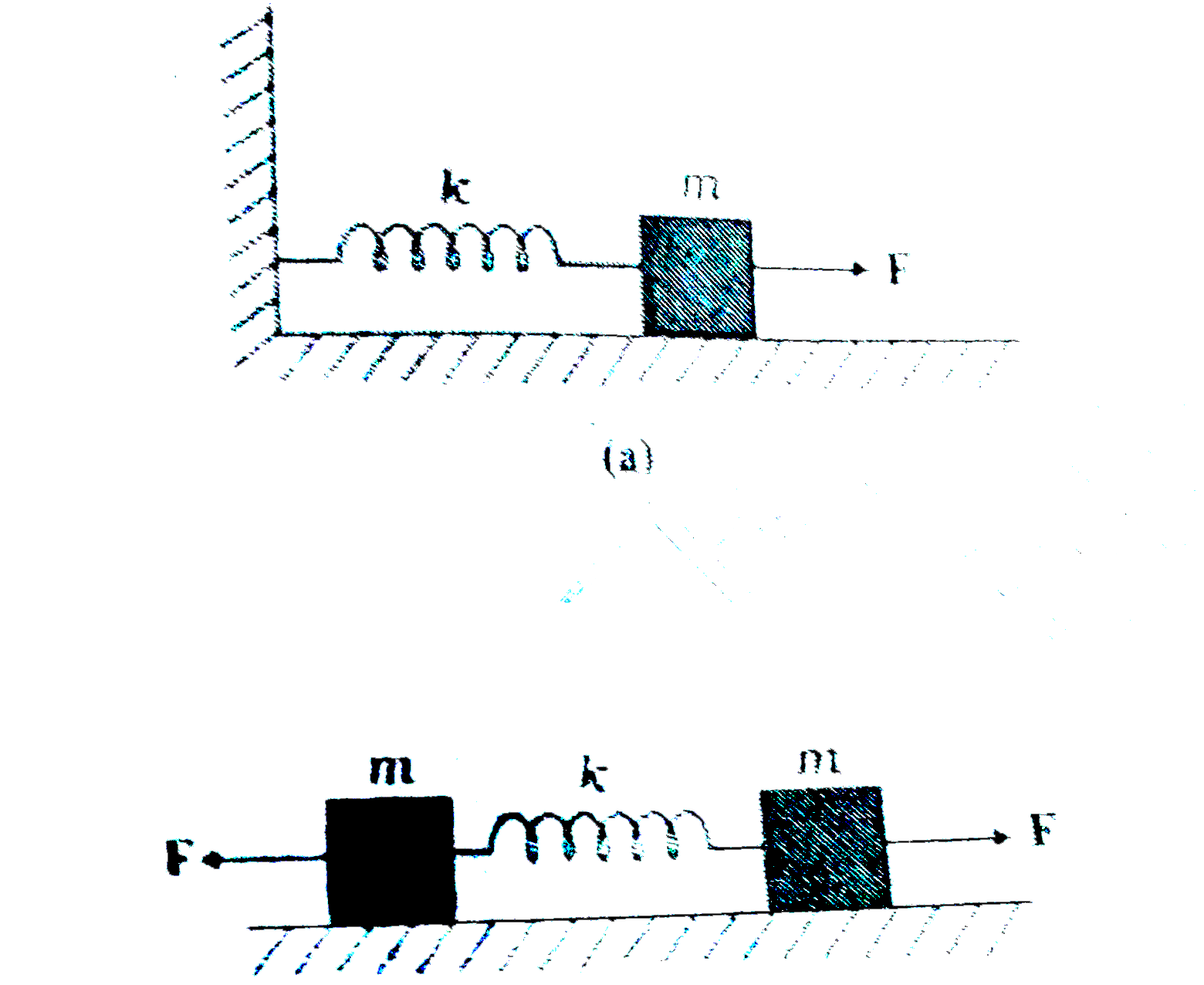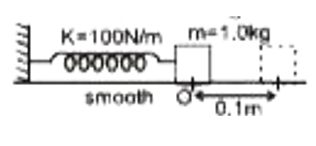A spring has a force constant of 100N/m and an unstretched length of 0.07m. One end is attached to a post that is free to rotate in the center of a smooth table as shown in the top view above. The other end is attached to a 1kg disc moving in uniform circular motion on the table which stretches the spring by 0.03 m. Friction is negligible. What is the centripetal force on the disc? A 0.3 N B 3N C 10 N D 300 N E 1 000 N
Correct option B 3NThe centripetal force is provided by the spring where FC = Fs = kx.
Related Solutions
चित्र 14.27 (a) में K बल-स्थिरांक की किसी कमानी के एक सिरे को किसी दृढ़ आधार से जकड़ा तथा दूसरे मुक्त, सिरे से एक द्रव्यमान m जुड़ा दर्शाया गया है | कमानी के मुक्त सिरे पर बल F आरोपित करने से कमानी तन जाती है | चित्र 14.30(b) में उसी कमानी के दोनों मुक्त सिरों से द्रव्यमान m जुड़ा दर्शाया गया है | कमानी के दोनों सिरों को चित्र 14. 30 में समान बल F द्वारा तानित किया गया है |

(a) दोनों प्रकरणों में कमानी का अधिकतम विस्तार क्या है ?
(b) यदि (a) का द्रव्यमान तथा (b) के दोनों द्रव्यमान को मुक्त छोड़ दिया जाए, तो प्रत्येक प्रकरण में दोलन का आवर्तकाल ज्ञात कीजिए |
View Solutionचित्र(a ) में k बल - स्थिरांक कि किसी कमानी के एक सिरे को किसी दृढ़ आधार से जकड़ा तथा दूसरे मुक्त सिरे से एक द्रव्यमान m जुड़ा दर्शाया गया है । कमानी के मुक्त सिरे पर बल F आरोपित करने से कमानी तन जाती है । चित्र ( b) में उसी कमानी के दोनों मुक्त सिरों से द्रव्यमान m जुड़ा दर्शाया गया है कमानी के दोनों सिरों को चित्र में समान बल F द्वारा तनित किया गया है ।

(i) दोनों प्रकरणों में कमानी का अधिकतम विस्तार क्या है ?
( ii) यदि (a ) का द्रव्यमान तथा (b ) के दोनों द्रव्यमानो को मुक्त छोड़ दिया जाता , तो प्रत्येक प्रकरण में दोलन का आवर्तकाल ज्ञात कीजिए।
View Solutionचित्र 14.27 (a) में K बल-स्थिरांक की किसी कमानी के एक सिरे को किसी दृढ़ आधार से जकड़ा तथा दूसरे मुक्त, सिरे से एक द्रव्यमान m जुड़ा दर्शाया गया है | कमानी के मुक्त सिरे पर बल F आरोपित करने से कमानी तन जाती है | चित्र 14.30(b) में उसी कमानी के दोनों मुक्त सिरों से द्रव्यमान m जुड़ा दर्शाया गया है | कमानी के दोनों सिरों को चित्र 14. 30 में समान बल F द्वारा तानित किया गया है |

(a) दोनों प्रकरणों में कमानी का अधिकतम विस्तार क्या है ?
(b) यदि (a) का द्रव्यमान तथा (b) के दोनों द्रव्यमान को मुक्त छोड़ दिया जाए, तो प्रत्येक प्रकरण में दोलन का आवर्तकाल ज्ञात कीजिए |
View SolutionOne end of an ideal spring of unstreched length l_(O)=1m , is fixed on a frictionless horizontal table. The other end has a small disc of mass 0.1 kg attached to it. The disc is projected with a velocity upsilon_(0)=11 m//s perpendicular to the spring. What is the force constant of spring?
View Solutionm = 1kg द्रव्यमान का एक ब्लॉक चिकनी (smooth) सतह पर रखा हुआ है और स्प्रिंग नियतांक k= 100N/m के स्प्रिंग से चित्रानुसार जुड़ा हुआ है तथा स्प्रिंग का दूसरा सिरा स्थिर दीवार से जुड़ा है। ब्लॉक को उसकी (स्प्रिंग की) प्राकृतिक लम्बाई से A= 0.10m दुरी तक खींचा जाता है एवं t=0 पर मुक्त करते है।

View SolutionFigure 14.26 (a) shows a spring of force constant k clamped rigidly at one end and a mass m attached to its free end. A force F applied at the free end stretches the spring. Figure 14.26 (b) shows the same spring with both ends free and attached to a mass m at either end. Each end of the spring in Fig. 14.26(b) is stretched by the same force F.

What is the maximum extension of the spring in the two cases ?
View SolutionFigure a) shows a spring of force constant k clamped rigidly at once end and a mass m attached to its free end. A force F applied at the free end stretches the spring. Figure b) shows the same spring with both ends free and attached to a mass m at either end. Each end of the spring in figure is stretched by the same force F.
(a) What is the maximum extension of the spring in the two cases ?
(b) If the mass in figure and the two masses in figure are released free, what is the period of oscillation in each case?

View Solutionspring of force constant k clamped rigidly at onoe end and a mass m attached to its free end. A force F applied at the free end stretches the spring. Figure shows the same spring with both ends free and attached to a mass m at either end. Each end of the spring in figure is stretched by the same force F.
(a) What is the maximum extension of the spring in the two cases ?
(b) If the mass in figure and the two masses in figure are released free, what is the period of oscillation in each case?

View SolutionFigure a) shows a spring of force constant k clamped rigidly at once end and a mass m attached to its free end. A force F applied at the free end stretches the spring. Figure b) shows the same spring with both ends free and attached to a mass m at either end. Each end of the spring in figure is stretched by the same force F.
(a) What is the maximum extension of the spring in the two cases ?
(b) If the mass in figure and the two masses in figure are released free, what is the period of oscillation in each case?

View SolutionFigure 14.26 (a) shows a spring of force constant k clamped rigidly at one end and a mass m attached to its free end. A force F applied at the free end stretches the spring. Figure 14.26 (b) shows the same spring with both ends free and attached to a mass m at either end. Each end of the spring in Fig. 14.26(b) is stretched by the same force F.

What is the maximum extension of the spring in the two cases ?
View SolutionFigure 14.26 (a) shows a spring of force constant k clamped rigidly at one end and a mass m attached to its free end. A force F applied at the free end stretches the spring. Figure 14.26 (b) shows the same spring with both ends free and attached to a mass m at either end. Each end of the spring in Fig. 14.26(b) is stretched by the same force F.

What is the maximum extension of the spring in the two cases ?
View SolutionFigure 14.26 (a) shows a spring of force constant k clamped rigidly at one end and a mass m attached to its free end. A force F applied at the free end stretches the spring. Figure 14.26 (b) shows the same spring with both ends free and attached to a mass m at either end. Each end of the spring in Fig. 14.26(b) is stretched by the same force F.

What is the maximum extension of the spring in the two cases ?
View SolutionFigure 14.26 (a) shows a spring of force constant k clamped rigidly at one end and a mass m attached to its free end. A force F applied at the free end stretches the spring. Figure 14.26 (b) shows the same spring with both ends free and attached to a mass m at either end. Each end of the spring in Fig. 14.26(b) is stretched by the same force F. What is the maximum extension of the spring in the two cases ?
View Solutionएक ऊर्ध्व स्प्रिंग मेज से खड़ा जुड़ा हुआ है । इसका बल नियतांक k है । m द्रव्यमान के एक गोले को स्प्रिंग के मुक्त सिरे के ठीक ऊपर से h ऊँचाई से गिराने पर स्प्रिंग d दूरी से पिचक जाता है इस प्रक्रम में हुआ शुद्ध कार्य होगा -
View Solution
One end of a spring is attached to a ceiling. When an object of mass m kilograms is attached to the other end of the spring, the spring stretches to a length of centimeters as shown in the equation above. What is m when is 73 ?
View SolutionA disc of mass m_(2) is placed on a table. A stiff spring is attached to it and is vertical. The other end of the spring is attached to a disc of mass m_(1) What minimum force should be applied to the upper disc to press the spring such that the lower disc is lifted off the table when the external force is suddenly removed?
View SolutionFigure 14.26 (a) shows a spring of force constant k clamped rigidly at one end and a mass m attached to its free end. A force F applied at the free end stretches the spring. Figure 14.26 (b) shows the same spring with both ends free and attached to a mass m at either end. Each end of the spring in Fig. 14.26(b) is stretched by the same force F.

If the mass in Fig. (a) and the two masses in Fig. (b) are released, what is the period of oscillation in each case ?
View SolutionFigure 14.26 (a) shows a spring of force constant k clamped rigidly at one end and a mass m attached to its free end. A force F applied at the free end stretches the spring. Figure 14.26 (b) shows the same spring with both ends free and attached to a mass m at either end. Each end of the spring in Fig. 14.26(b) is stretched by the same force F.

If the mass in Fig. (a) and the two masses in Fig. (b) are released, what is the period of oscillation in each case ?
View SolutionFigure 14.26 (a) shows a spring of force constant k clamped rigidly at one end and a mass m attached to its free end. A force F applied at the free end stretches the spring. Figure 14.26 (b) shows the same spring with both ends free and attached to a mass m at either end. Each end of the spring in Fig. 14.26(b) is stretched by the same force F. If the mass in Fig. (a) and the two masses in Fig. (b) are released, what is the period of oscillation in each case ?
View SolutionFigure 14.26 (a) shows a spring of force constant k clamped rigidly at one end and a mass m attached to its free end. A force F applied at the free end stretches the spring. Figure 14.26 (b) shows the same spring with both ends free and attached to a mass m at either end. Each end of the spring in Fig. 14.26(b) is stretched by the same force F. If the mass in Fig. (a) and the two masses in Fig. (b) are released, what is the period of oscillation in each case ?
View Solution